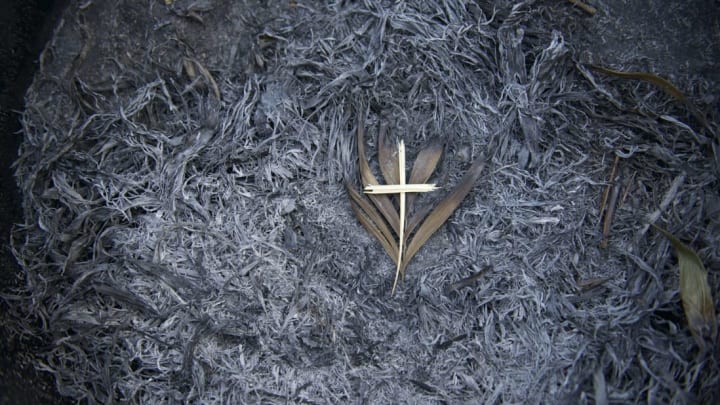In 2021, millions of Christians around the world will celebrate Ash Wednesday on February 17, 2021, to mark the start of the Lenten season. The practice of marking worshippers' foreheads with ashes in the shape of a cross is one of Christianity's most visible rituals, but it's just one component of the holy day. Whether or not you observe it, here are some facts about Ash Wednesday worth knowing.
1. Not all Christians observe Ash Wednesday.

While Ash Wednesday is perhaps most closely associated with Catholicism, there are many Christian sects that recognize it, including Lutherans, Methodists, Episcopalians, Presbyterians, and some Baptists. There are also Christians that refrain from Ash Wednesday celebrations. Mormons, Evangelicals, and Pentecostal Christians are some of the denominations that don't take part in the holy day.
2. The ash has biblical significance.

The ashes used on Ash Wednesday are meant to represent dust. When receiving ashes on their foreheads, parishioners hear the words: "Remember you are dust, and to dust you shall return." This is a reference what God says to Adam when exiling him from the Garden of Eden (in the Christian Bible, Adam is literally formed from dust). On Ash Wednesday, the saying is a reminder to be humble in the face of mortality.
3. The history of Ash Wednesday is less than 1000 years old.

The first Ash Wednesday ceremonies were likely held sometime in 11th century CE. It's never mentioned in the Bible, but there is a verse in the Book of Daniel that links fasting to ashes, and some scholars believe this is the origin of the Lenten practice. Ash Wednesday didn't gain mainstream popularity with Christians in the U.S. until the 1970s.
4. Ashes are recycled from last Lent.

The ashes used on Ash Wednesday are surprisingly eco-friendly. On Palm Sunday, the Sunday before Easter, many churches pass out palm fronds like those used to welcome Jesus Christ to Jerusalem days before his crucifixion. Some churches save those palms to burn them and make the ashes that are applied to peoples' foreheads roughly 11 months later.
5. There are rules about what you can eat on Ash Wednesday.

Ash Wednesday is a day of fasting. For many Christians, that doesn't mean abstaining from food completely. Instead, observers of the holy day should limit themselves to one whole meal plus two smaller meals that, when added up, don't equal a meal they would eat on a normal day. Christians marking Ash Wednesday should also avoid eating meat like they would on Fridays during Lent. (Filet-o-fish is still fine to eat, though.)
6. In Iceland, Ash Wednesday can look like Halloween.

The Tuesday before Ash Wednesday is normally reserved for indulgence and revelry (think: Mardi Gras), but in Iceland, the fun doesn't stop there. The first day of Lent in Iceland, called Öskudagur, is similar to Halloween in the U.S. Kids dress up in costumes and tour their neighborhoods singing songs in exchange for candy. The holiday even makes room for mischief—in one fading tradition, kids will sometimes pin "ash bags" (often filled with grains instead of ash) to the backs of their peers when they aren't looking.
7. You can get ashes without going to church.

Many parishes have started offering "ashes to go" on Ash Wednesday. Priests and pastors will often station themselves in public places—like street corners, parking lots, and public transit stops—prepared to administer blessed ashes to whoever asks to receive them.
Along those lines, you don't need to be a church leader to administer ashes. Many churches give parishioners the option to take packets of ashes home with them to apply to the foreheads of loved ones who couldn't make it to the service. Receiving ashes isn't a sacrament, so the rules surrounding it aren't as strict as they are with something like holy communion in the Catholic Church.
